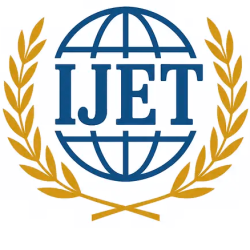
DEVELOPMENT OF A STABLE CERAMIC MATERIAL FOR HIGH TEMPERATURE APPLICATIONS IN CONSTRUCTION: CASE STUDY OF HIGH TEMPERATURE RESISTING BRICKS | IJET – Volume 11 Issue 5 | IJET-V11I5P25

Table of Contents
ToggleInternational Journal of Engineering and Techniques (IJET)
Open Access • Peer Reviewed • High Citation & Impact Factor • ISSN: 2395-1303
Volume 11, Issue 5 | Published: October 2025
Author: MOUNDOM Amadou, MINSANGLISIMBOM Pleasant , TANGKA KEWIR Julius, MANJIA Marcelline Blanche , MBESSA Michel , TAMO TATIETSE Thomas
Abstract
Insulating ceramic boards are sought in various industries, civil engineering workshops and even in homes for numerous uses but its manufacture is quite complex. This research work was aimed at developing a stable ceramic material (high temperature bricks) for high temperature applications in building construction. Insulating ceramic boards were made from clay which was the predominant raw material, sawdust, white Portland cement (WPC) and sand by combining the raw materials in different ratios [ A (60% clay + 30% WPC + 10% sand), B (65% clay + 25% WPC +10% sand), C (70% clay + 20% WPC +10% sand), D (75% clay + 15% WPC +10% sand), E (80% clay + 10% WPC +10% sand), F (57.14 % clay + 28.57% WPC + 9.52 % sand + 4.77% sawdust), G (61.90 % clay + 23.81 % WPC + 9.52 % sand + 4.77 % sawdust), H (66.67% clay + 19.05% WPC + 9.52 % sand + 4.77% sawdust), I (71.43% clay +14.29% WPC + 9.52 % sand + 4.77% sawdust), J(76.19% clay + 9.52 WPC + 9.52 % sand + 4.77% sawdust)]. The raw materials were mixed, the green ceramic materials were formed in a mould of 60 × 25 × 2.5 cm, dried at ambient temperature, fired at a temperature range of 900 – 1303 °C and allowed to cold in the kiln. The ceramic boards were then removed and their physical, mechanical and thermal properties determined. Experimental results showed that the apparent porosity values of all the specimens were between 55.42 and 67.28% which are in the international standard range (ISO 5016-1986) of 20 – 80%. The bulk density values of all the specimens were between 1.63 and 1.71 g/cm3 bringing them closer to the British standard range (BS, 1902 part B 1976 ) of 1.71- 2.1 g/cm3. The thermal conductivity values of all the specimens were between 0.31 and 0.94 W/m.k which fall in the ASTM specifications (C177-2023) of 0.01-1.1 W/m.k except for specimen A, B, G, and H which had higher values. The compressive strength of all the specimens were between 2.27 and 6.66 MPa, complying to the ASTM (C64 -2012) which recommends 1.3MPa as the minimum compressive strength value for insulating ceramic boards. None of the specimens absorbed more than 20% water of its own weight in conformity with ASTM (C140-2020). All the specimens had very high specific gravity values not complying with the ASTM (D792 – 2017) range of 2.6 – 2.7. Based on these results, it can be said that specimen I (71.43% clay +14.29% WPC + 9.52 % sand + 4.77% sawdust) is a good substitute for imported insulating ceramic materials used for high temperature application in building construction.
Keywords
Local materials, insulating ceramic boards, physical properties, mechanical properties.
Conclusion
Insulating ceramic boards are sought in various industries, civil engineering workshops and even in homes for numerous uses but its manufacture is quite complex. This research work was aimed at developing a stable ceramic material (high temperature bricks) for high temperature applications in building construction. Insulating ceramic boards were made from clay which was the predominant raw material, sawdust, white Portland cement (WPC) and sand by combining the raw materials in different ratios [ A (60% clay + 30% WPC + 10% sand), B (65% clay + 25% WPC +10% sand), C (70% clay + 20% WPC +10% sand), D (75% clay + 15% WPC +10% sand), E (80% clay + 10% WPC +10% sand), F (57.14 % clay + 28.57% WPC + 9.52 % sand + 4.77% sawdust), G (61.90 % clay + 23.81 % WPC + 9.52 % sand + 4.77 % sawdust), H (66.67% clay + 19.05% WPC + 9.52 % sand + 4.77% sawdust), I (71.43% clay +14.29% WPC + 9.52 % sand + 4.77% sawdust), J(76.19% clay + 9.52 WPC + 9.52 % sand + 4.77% sawdust)]. The raw materials were mixed, the green ceramic materials were formed in a mould of 60 × 25 × 2.5 cm, dried at ambient temperature, fired at a temperature range of 900 – 1303 °C and allowed to cold in the kiln. The ceramic boards were then removed and their physical, mechanical and thermal properties determined. Experimental results showed that the apparent porosity values of all the specimens were between 55.42 and 67.28% which are in the international standard range (ISO 5016-1986) of 20 – 80%. The bulk density values of all the specimens were between 1.63 and 1.71 g/cm3 bringing them closer to the British standard range (BS, 1902 part B 1976 ) of 1.71- 2.1 g/cm3. The thermal conductivity values of all the specimens were between 0.31 and 0.94 W/m.k which fall in the ASTM specifications (C177-2023) of 0.01-1.1 W/m.k except for specimen A, B, G, and H which had higher values. The compressive strength of all the specimens were between 2.27 and 6.66 MPa, complying to the ASTM (C64 -2012) which recommends 1.3MPa as the minimum compressive strength value for insulating ceramic boards. None of the specimens absorbed more than 20% water of its own weight in conformity with ASTM (C140-2020). All the specimens had very high specific gravity values not complying with the ASTM (D792 – 2017) range of 2.6 – 2.7. Based on these results, it can be said that specimen I (71.43% clay +14.29% WPC + 9.52 % sand + 4.77% sawdust) is a good substitute for imported insulating ceramic materials used for high temperature application in building construction. With regard to the results obtained and the conclusions that followed, the recommendation of using correct proportions of all ingredients in the fabrication of insulating ceramic materials was made.
References
Ajala, A. J., & Badarulzaman, N. A. (2016). Thermal Conductivity of Aloji Fireclay as Refractory Material. International Journal of Integrated Engineering, 8(3), 16–20. https://core.ac.uk/download/pdf/268563059.pdf. Akinfolarin, J. F., & Awopetu, O. O. (2014). The Effect of Sawdust on the Insulating Effect of Ikere Clay as Refractory Lining. AU J.T., 17(3), 143–147. https://scirp.org/reference/referencespapers.aspx?referenceid=1654547.
Al-nawafleh, M. A. (2009). Mechanical and physical properties of silica bricks produced from local materials. Australian Journal of Basic and Applied Sciences, 3(January), 418–423. https://doi.org/https://www.researchgate.net/publication/293750382.
ASTM C64, (2012). Specification for fireclay brick refractories for heavy duty stationry boiler.
ASTM C177, (2023). Standard test method for steady state heat flux measurement and thermal transmission properties by means of the guarded-hot-plate apparatus. Benjeddou, O., Soussi, C., Khadimallah, M. A., Alyousef, R., & Jedidi, M. (2018). Development of new baked bricks based on clay and sawdust. MATEC Web, 4(01), 1–8. https://doi.org/https://doi.org/10.1051/matecconf/201814901040.
Boch, P., & Niepce, J.-C. (2007). Ceramic Materials, Processes, Properties and Applications. https://www.wiley.com/en-bb/Ceramic+Materials:+Processes,+Properties,+and+Applications-p-9780470612415.
Duan, P., Yan, C., Zhou, W., & Luo, W. (2016). Fresh properties , mechanical strength and microstructure of fly ash geopolymer paste reinforced with sawdust. Construction & building materials, 111(02), 600–610. https://doi.org/10.1016/j.conbuildmat.2016.02.091.
Dubreuip, P., & Sobolev, V. M. (1999). Andalusite: a promising material for manufacturing high-quality refractories. 40(3), 151–158. https://link.springer.com/content/pdf/10.1007/BF02762372.pdf.
Eliche-quesada, D., & Pérez-villarejo, L. (2019). Introduction to Ceramic Materials: Synthesis, Characterization, Applications, and Recycling. IntechOpen, 1–5. https://doi.org/http://dx.doi.org/10.5772/intechopen.84710.
H. Al-Taie, M., H. Ali, A., & F. Al-Attar, A. (2014). Study the Physical Properties and Thermal Conductivity of Light Weight Refractories Bricks Produced by Adding porcelanite to Kaolinite. Eng. &Tech.Journal, 33(1), 51–60. https://www.iasj.net/iasj/pdf/c506af01ff6903f1.
Hamza, R., Hamza, R. A., & Khedr, S. (2011). Marble and Granite Waste : Characterization and Utilization in Concrete Bricks Marble and Granite Waste : Characterization and Utilization in Concrete Bricks. International Journal of Bioscience, Biochemistry and Bioinformatics, 1(12), 286–291. https://doi.org/10.7763/IJBBB.2011.V1.54.
Holdren, J. P. (1991). Population and the Energy Problem. A Journal of Interdisciplinary Studies, 12(3), 231–255.
Hwaidy, K. E. Al, Hassan, S. S., & Eedan, O. A. (2018). Study the effect of using local materials as refractory bonding mortar in iraqi. kufa Journal of Engineering, 9(1), 143–157.
Iyasara, A. C., Joseph, M., & Azubuike, T. C. (2014). The Use of Local Ceramic Materials for the Production of Dental Porcelain. American Journal of Engineering Research (AJER), 3(9), 135–139. https://www.ajer.org/papers/v3(9)/R03901350139.pdf.
Iyasara A. C., Joseph, M., Azubuike, T. C., & T, T. D. (2015). Exploring ceramic raw materials in nigeria and their exploring ceramic raw materials in nigeria and their contribution to nation ’ s. American Journal of Engineering Research (AJER), 3(September), 127–134. https://www.ajer.org/papers/v3(9)/Q03901270134.pdf.
Jo, O., & Philip, C. (2014). Performance Evaluation of Refractory Bricks produced from locally sourced Clay Materials. Journal of a pplied s cience and environmental management, 18(2), 151–157. https://doi.org/http://dx.doi.org/10.4314/jasem.v18 i2.1.
Jock, A. A., Ayeni, F. A., Ahmed, A. S., & Sullayman, U. A. (2013). Evaluation of the Refractory Properties of Nigerian Ozanagogo Clay Deposit. Journal of Minerals and Materials Characterization and Engineering, 1(November), 321–325. https://doi.org/http://dx.doi.org/10.4236/jmmce.2013.16048 Evaluation.
Kadhum, M., & Jaffer, H. A. (2013). Study of the Thermal Durability of Refractory Mortar Prepared from Local Clay Mixed with Different Percentage of Silica. Iraqi Journal of Science, 54(4), 1096–1101. https://www.iasj.net/iasj/pdf/511003d8ebb4664b.
Katte Y.V., Seukep N. J.F., Moundom A., Wouatong L. S. A. and Kamgang K.B.V., (2017). The Effect of Partial Replacement of Waste Water Treatment Sludge on The Properties of Burnt Clay Brick. International Journal of Civil Engineering and Technology, Volume 8, Issue 6, June 2017, pp. 567-583.
Kenfack, P. L., Tematio, P., & Gabriel, N. (2011). Evidence of a Miocene volcano-sedimentary lithostratigraphic sequence at Ngwa ( Dschang Region , West Cameroon ): Preliminary analyses and geodynamic interpretation. Journal of Petroleum Technology and Alternative Fuels, 2(25–34). https://www.researchgate.net/publication/26542179
Kenfack J. F., Tsalefac M., & Kongnso M. E. (2020). International Journal of Social Science and Economic Research. International Journal of Social Science and Economic Research, 7(03), 687–707. www.ijsser.org.
Manukaji, J. (2013). The Effects Of Sawdust Addition On The Insulating Characteristics Of Clays From The Federal Capital Territory Of Abuja. International Journal of Engineering Research and Applications (IJERA), 3(2), 6–9. https://www.ijera.com/papers/Vol3_issue2/B32006009.pdf.
Moundom A., Katte Y. V., Abanda Ngono B. and Amboko Muhiwa B., (2022). Physico-mechanical properties of stabilized mud bricks with palm nut fibres in Ndong village, Mfou district, Mefou -Afamba division in the Centre Region of Cameroon. International Journal of Engineering and Techniques (IJET), Volume 8, Issue 1, January 2022, pp. 70-87.
Obstler, M. (2012). understanding ceramic glaze materials and clay making ingredients. Ceramic Artsdaily.Org, 2, 1–15. https://claybucket.com/wp-content/uploads/cadaily-RawMaterials_2.pdf.
Ojukwu, V. E., & Ajemba, R. O. (2022). The effect of sawdust , cow dung , and CaC 2 wastes on properties of refractory bricks. Journal of Engineering and Applied Sciences, 21(1), 799–812. https://journals.unizik.edu.ng/index.php/ujeas/article/download/1844/1501.
Olufunke, A.-A., & Mofolorunsho John, S. (2021). Barrel Kiln : A Practical Alternative to Firing in Ceramics Production. International Journal of Innovative Science, Engineering & Technology (IJISET), 8(9), 1–10. https://ijiset.com/vol8/v8s9/IJISET_V8_I09_01.pdf.
Otero, J. G., Blanco, F., Garcia, M. P., & Ayala, J. (2004). Manufacture of refractory insulating bricks using fly ash and clay. Institute of Materials, Minerals and Mining, 103(4), 181–187. https://doi.org/10.1179/096797804225018714.
Panennungi, T., & Rauf, B. A. (2005). Analysis of Brick Compressive Strength and Water Absorption Based on Various Furnace Duration. Proceeding of The International Conference on Science and Advanced Technology (ICSAT), 1, 308–316. https://ojs.unm.ac.id/icsat/article/download/17603/9618.
Reddy, K. R. T., Rao, K. S., & Rambabu, K. (2018). Influence of cooling method on steel fiber reinforced concrete exposed. Journal of Emerging Technologies and Innovative Research (JETIR) Www.Jetir.Org, 5(1), 370–373.
Rzepa, K., Wons, W., & Reben, M. (2016). Building ceramics with improved thermal insulation parameters. 00082, 1–6. https://doi.org/10.1051/e3sconf/20161000082.
Samad, A., Akhtar, U. S., Ahmed, K. S., & Roy, S. C. (2021). Manufacture of refractory brick from locally available red clay blended with white portland cement and its performance manufacture of refractory brick from locally available red clay blended with white portland. International Journal of geomate, 20(3), 105–112. https://doi.org/https://doi.org/10.21660/2021.80.j2033.
Tazen, F., Fonteh, M., & Karambiri, H. (2013). Gestion intégrée des ressources en eau dans le bassin versant du lac municipal de Dschang : connaissance et usages. International Journal of Biological and Chemical Sciences, 7(2), 840–851. https://doi.org/10.4314/ijbcs.v7i2.39.
Velasco, P. M., Ortíz, M. P. M., Giró, M. A. M., & Velasco, L. M. (2014). Fired clay bricks manufactured by adding wastes as sustainable construction material – A review. 63(01), 97–107. https://doi.org/10.1016/j.conbuildmat.2014.03.045
Vitiello, D., Poirier, J., Tessier-doyen, N., & Nait-ali, B. (2021). Thermo-physical properties of insulating refractory materials. In Ph.D. Thesis (pp. 1–118). https://theses.hal.science/tel-03289147/document
Walker, H. (2005). Harbison-Walker Handbook of Refractory Practice. https://www.mha-net.org/docs/Harbison%20Walker%202005%20Handbook.pdf.
© 2025 International Journal of Engineering and Techniques (IJET).

Digital Object Identifier (DOI)
IJET assigns a unique DOI to every accepted article via Zenodo for persistent linking and citation. Your article’s DOI: https://doi.org/{{doi}}

Citations & Discovery
Citations are tracked via Google Scholar and DOI lookups. Use the links below to find where this article is cited.
- Google Scholar: Search Citations
- DOI Resolver: Open DOI




